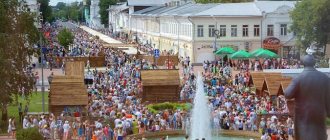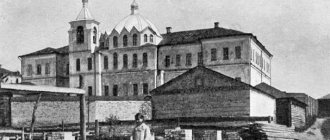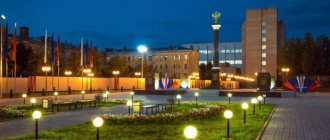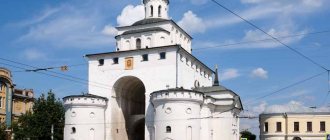How Bryansk will celebrate City Day: Zhirinovsky, artillery salute and festive fireworks
The city of Bryansk turns one thousand thirty-three in September, and the wonderful holiday of the city’s birthday is celebrated on September seventeenth. In addition, on Monday, guests and residents of the city will celebrate seventy-five years since the liberation of Bryansk from the Nazi invaders.
The celebration will begin on Lenin Square at 11.00. The ceremonial march of troops and the parade of military equipment starts from here. The column will pass along Lenin Avenue to Partizan Square. The procession will be led by the legendary T-34 tank, followed by T72BA tanks, Tornado multiple launch rocket systems, mortar howitzers and other military vehicles. Those who stand guard over the world today will follow. For the first time, about a thousand military personnel from active units will march along Lenin Avenue in parade formations. The final stage will be a parade column of residents and guests of the city, led by veterans of the Great Patriotic War.
The highlight of the holiday will be the historical reconstruction of the battles for Bryansk. You can see it at 17.00 at the old airport. More than 200 reenactors from Moscow and Vologda, Volgograd and Brest, St. Petersburg and Minsk will take part in the battle. They will show military maneuvers, authentic equipment, uniforms and even weapons.
In the evening, festivities will take place in the park named after the 1000th anniversary of Bryansk. Residents and guests of Bryansk will enjoy performances by the song and dance ensemble of the Western Military District, a symphony orchestra, singer Alexander Dobronravov and Honored Artist of Russia singer Varvara. The holiday will end with an artillery salute of 30 salvos at the old airport. At the same time, fireworks will go off on the Mound of Immortality.
Where to go in Bryansk on September 17, 2022
11.00 — Parade of troops and military equipment “We are the country’s army! We are the army of the people!”
Where: Lenin Square - Partizan Square
12.30 — Parade of Generations
Where: Lenin Avenue
13.00 – Rally “Bryansk Street leads us to victory!”
Where: Partizan Square
14.00 — Concert of the military exemplary orchestra “Let’s sing, friends together!” Demonstration performances of the honor guard company.
Where: Partizan Square
14.00 — Exhibition of military equipment
Where: Krasnoarmeyskaya street
15.00 — Festival of national creativity “Real Russia”. Performance by creative groups from Bryansk, Volgograd, Gomel, Mogilev
Where: Partizan Square
13.00 — Concert of the Bryansk City Pop Orchestra “To you, dear fellow countrymen!”
Where: Theater Square
13.30 — Festival of brass bands “On Bryanskaya Street with an orchestra”
Where: Slavyanskaya Square
17.00 — Historical reconstruction “For the Motherland! For my native city!
Where: old airport
14.30 — Concert from creative groups of the city “To you, beloved city!”
15.20 — Concert of the author of the “Afghan song” Valery Petryaev
16.00 — Concert of performers of the patriotic song “Katyusha”
17.30 — Concert of the song and dance ensemble of the Western Military District
18.30 — Concert of soloists of creative groups of the Bryansk region, accompanied by the governor’s symphony orchestra “Songs of Victory”
20.00 — Concert of singer Alexander Dobronravov
20.30- Concert of ethno-pop singer Varvara
Where: Main stage, park named after the 1000th anniversary of Bryansk
21.30 — Artillery salute and festive fireworks
Where: territory of the old airport, Mound of Immortality
City information
Bryansk is located in the western part of Russia and is the administrative center of the region of the same name. Located on the banks of the Desna River.
The economy is represented by enterprises of heavy engineering, metalworking, chemical, electrical, and woodworking industries.
Federal highways pass through the settlement: M3, M13, A141. Large railway junctions operate. There are universities and their branches, secondary specialized educational institutions, and sports schools. There are cultural institutions: theaters, museums, concert halls. The population exceeds 400 thousand people.
Andrei Kartapolov and Vladimir Zhirinovsky will come to Bryansk for City Day
Deputy Minister of Defense of Russia, Head of the Main Military-Political Directorate of the Armed Forces, Colonel General Andrei Kartapolov will arrive in Bryansk to celebrate City Day. BryanskToday learned about this.
Andrey Kartapolov will take part in the celebrations marking the 75th anniversary of the liberation of the city from the Nazi invaders. This year, Bryansk will host festive events of unprecedented scale.
The decoration of City Day will be a parade of military equipment, in which T-72 tanks, BMP-2 tanks, artillery rocket launchers, and armored personnel carriers will take part. The column of equipment will be led by the legendary T-34 tank.
Let us remind you that this coming Monday, September 17, Bryansk will celebrate City Day, the 75th anniversary of liberation from the Nazis. Many high-ranking guests will come to the celebration.
Among them will be the leader of the LDPR, Vladimir Zhirinovsky. The Bryanskaya Street website reports this with reference to its sources. It is likely that he will take part in the parade.
Vladimir Zhirinovsky will also talk to the townspeople.
The UN predicted a population decline for Bryansk
The UN Department of Economic and Social Affairs included Bryansk among the Russian cities with the most declining population. As TASS writes, the number of Russian cities with a declining population since 2000 includes Nizhny Novgorod (from 1.331 million to 1.264 million people), Bryansk (435 thousand - 404 thousand) and Nizhny Tagil (398 thousand - 354 thousand). ).
Subsequently, the United Nations gave a disappointing forecast for Bryansk - the population of Bryansk will continue to decline. According to experts, this state of affairs is explained not only by low birth rates, but also by migration.
In Russia as a whole, the population of Russian cities by the middle of the 21st century will grow by 3 million people and exceed 110.6 million, even despite the demographic crisis. At the same time, the UN says, the decline in the country's population will be most acutely felt in villages. The number of their inhabitants by 2050 will decrease by one and a half times, from the current 36.8 million to 22.1 million.
For comparison, the population of rural areas in the RSFSR in 1950, from which the UN keeps such statistics, was 57.5 million. Since then, it has been steadily declining due to the process of urbanization.
According to the UN, based on estimates from national statistical agencies, about 144 million people currently live in Russia, with the share of the urban population being 74.4% (107.2 million). According to the latest forecasts, by 2050 this figure will reach 83.3%, and the country's total population will decrease to 132.7 million.
The population of Moscow, which reached 10 million in 2000 and surpassed 12 million three years ago, according to UN experts, will not grow at such a rapid pace in the near future. After 2025, the number of residents of the Russian capital will reach 12.8 million and will remain at this level until 2035, which is limited by DESA forecasts. At the same time, Moscow will remain the most populous city in Europe.
The population of St. Petersburg will also grow slightly by 2035: from the current 5.4 million to 5.6 million. Krasnodar will become a millionaire city, and Sochi will come close to the 500 thousand mark, TASS notes.
According to statisticians, as of January 1, 2022, the population of the Bryansk urban district was 425 thousand people (including the suburban villages included in the district). In 2012, 432 thousand people lived in Bryansk. The largest number of residents in Bryansk was in 1997 - 462 thousand people. In Bryansk, population growth was observed throughout the Soviet period. The decline in numbers began in the 1990s.
Bryansk - 1033rd anniversary of the city
Bryansk is a Russian city, the capital of the Bryansk region, located at the confluence of the Bolva and Snezheti rivers into the Desna River. The exact date of its foundation is not known; in ancient chronicles the city is mentioned as Debryansk. It is generally accepted that the founding year is 985, although this date is very arbitrary. Initially, Bryansk was part of the Chernigov principality. But after the destruction of Chernigov and other cities of the principality by the Mongol-Tatars, the Bryansk principality was formed. In 1356, Bryansk was taken by the Lithuanian prince Olgerd and became part of the Grand Duchy of Lithuania.
Bryansk was annexed to the Moscow State in 1500 by the army of Ivan III. In the 15th century, a war with Poland began, the city became a stronghold of Russian forces. In 1607 it was attacked twice by the troops of False Dmitry II. The first time it was burned by the residents so as not to fall to the enemy, it was rebuilt by the end of the year. In the 17th century, Bryansk found itself at the center of trade routes between Russia and Ukraine, and the city experienced significant growth.
During the time of Peter I, a shipyard was founded here, ships of the Bryansk flotilla were built, and an arsenal for the production of artillery was founded. Almost at the beginning of the Great Patriotic War and until 1943, the city was occupied by the German army. In the forests near Bryansk there was a center of the partisan movement; the number of partisans reached 60 thousand people.
In 1944, the Bryansk region was formed, and Bryansk became its center. Today Bryansk is a large industrial center, famous for the production of diesel locomotives, agricultural equipment and light industrial goods. In 2010, Bryansk was awarded the honorary title “City of Military Glory”.
Bryansk
A city in the Russian Federation, the administrative center of the Bryansk region, a city of regional significance, forms the municipal entity of the city of Bryansk with the status of an urban district.
It is located on the western edge of the Central Russian Upland, on both banks of the Desna River at the confluence of the Bolva and Snezheti.
The city is divided into 4 urban districts: Bezhitsky (includes the village of Raditsa-Krylovka), Volodarsky (includes the village of Bolshoye Polpino), Sovetsky, Fokinsky (includes the urban village of Belye Berega).
Bryansk is a large cultural, industrial center and logistics hub. The city is located in central Russia on the border with Ukraine and Belarus.
About a third of the region’s population lives in the city - about 420 thousand people (data for 2022). The total area of the city is 230 square kilometers.
History of the city of Bryansk
Bryansk, one of the oldest Russian cities, was founded in 985 as a Slavic fortified settlement on the high right bank of the Desna River. The original name of the city - "Debryansk" - is associated with the "wilds" surrounding the city - dense and impenetrable forests. Bryansk was first mentioned in the Ipatiev Chronicle in 1147: Prince Svyatoslav Olgovich of Novgorod took refuge in it. At this time, the city was part of the Chernigov principality.
Since 1252, the city acquired the status of the capital city of the appanage Bryansk principality, founded in 1246 by Prince Roman of Chernigov, who moved his capital here from Chernigov, devastated by Khan Batu. Under him, Bryansk became the political, economic and spiritual center of the region.
In 1356, the Principality of Bryansk was captured by the Grand Duchy of Lithuania, under whose rule Bryansk was for almost a century and a half. Only in 1500 did Russian troops capture the city. In 1503, after the end of the war between Ivan III and Lithuania, the northern part of the Bryansk Principality finally became part of the Moscow state.
Since that time, Bryansk has become an important fortress city on the southwestern borders of the state. At the same time, in the 16th century, on the site of the former Bryansk principality, the Bryansk district was formed, governed by governors.
During the Peter the Great era, a number of decrees were issued aimed at boosting industry and trade in the city. The annual fair held at the walls of the Svensky Monastery, one of the largest fairs in Russia, acquired a large role.
In 1708, Peter I visited Bryansk. By order of the tsar, a shipyard was founded in the city, where ships of the Bryansk flotilla were built.
In 1778, Bryansk became a county town in the Oryol province with its own coat of arms, noting its merits in the production of weapons and defense of the state.
In 1783, by decree of Catherine II, the construction of the Bryansk Arsenal began, and by the spring of 1785 the first cannons were cast here. Every fourth cannon that was in service with the Russian army in the Patriotic War of 1812 bore the mark of the Bryansk Arsenal. Rope spinning, tobacco, brick, sawmill and flour milling industries also developed in the city. Trade in timber, hemp, and hemp oil, sent to Moscow and the ports of Riga and St. Petersburg, was significant. By that time, the city had more than 13 thousand inhabitants.
With the construction of the Orel-Vitebsk railway in 1868, Bryansk was included in the transport network of Russia. In 1873, a rail rolling and iron-making mechanical plant was founded in the village of Bezhitsa, which soon became the largest enterprise for the production of steam locomotives and carriages.
After the Civil War, the city of Bryansk briefly became the center of a new territorial entity - the Bryansk province (1921-1929), after which it became part of the Western and then the Oryol region. During the Soviet period, the city grew into a major industrial center of the country. In 1931, the Bryansk State District Power Plant, built according to the GOELRO plan, came into operation.
The fighting during the Great Patriotic War and the occupation (October 1941 - September 1943) destroyed the city. The dedication of the residents who formed the people's militia, which bravely resisted the invaders, brought Bryansk the honorary title “City of Combat and Partisan Glory.” On September 17, 1943, Bryansk was liberated. Nowadays this day is celebrated as City Day.
In 1944, Bryansk became a regional center and in November 1945, by a special decree of the Soviet government, it was included in the list of fifteen oldest Russian cities subject to priority restoration. After the war, restoration began with the machine-building (locomotive) plant, which already produced the first steam locomotive in 1946.
In 1979, the city was awarded the Order of the October Revolution for success in economic and cultural construction, services in the revolutionary movement, courage and fortitude of workers during the Great Patriotic War, and active participation in the partisan movement. In 1985, for achievements in economic and cultural construction and in connection with the 1000th anniversary, Bryansk received the Order of the Red Banner of Labor.
On March 25, 2010, for the courage, resilience and mass heroism shown by the city’s defenders in the struggle for freedom and independence of the Fatherland, Bryansk was awarded the honorary title of the Russian Federation “City of Military Glory.”
Archeology
According to the Bryansk Museum of Local Lore, it currently contains more than 90 thousand items. This is one of the largest and most significant collections. It includes items discovered during archaeological research in the Bryansk region: tools, beads, bracelets, rings and other various finds.
Of particular value are the items discovered during the study of famous archaeological monuments of the Bryansk region: Khotylevo, Negotino, Eliseevichi, Timonovka, Yudinovo, Suponevo... The Bryansk region is rich in archaeological monuments, there are about 900 of them on its territory.
One of the oldest artifacts discovered in the Bryansk region is a flint spear tip. It is about 100 thousand years old. Despite such a considerable age, it is a real masterpiece in terms of care and beauty. The tip was found by an outstanding archaeologist and employee of our museum, Fyodor Mikhailovich Zavernyaev, at the Khotylevo-I site, 20 km from Bryansk.
At the neighboring parking lot Khotylevo-II F.M. Zavernyaev discovered two figurines of a woman made from mammoth ivory under a four-meter thick layer of earth. The age of these finds is about 18 thousand years. The figurines are one of the oldest works of art in the world. This is how the first “Paleolithic Venuses” appeared in the museum’s collection – this is the name these figurines received. These figurines are an archaeological rarity: about 100 of them have been found in the world.
Paleolithic collections from the funds of the Belarusian State Conservatory are comparable in volume, significance and value only to the collections of such major academic museums in Moscow and St. Petersburg as the State Historical Museum, the Museum of the Research Institute of Anthropology of Moscow State University, and the Kunstkamera.
Every year, domestic and foreign researchers work with the museum’s collections: archaeologists, philologists, museum employees, graduate students and undergraduates.
Coat of arms of the city of Bryansk
The Bryansk coat of arms is one of the oldest coats of arms of Russia; it was created in the first half of the 18th century. The opportunity to use an ancient coat of arms is a rare and high honor, which out of more than 20,000 municipalities currently existing in Russia can be enjoyed by less than 500.
For the first time, the coat of arms of Bryansk appeared on the banners of the Bryansk Landmilitary Regiment. Its first description appeared in 1730 in the collection of banners of the regiments of the Russian Empire - Znamenny Armorial. In 1781, Empress Catherine II, together with other coats of arms of the cities of the Oryol governorship, approved the coat of arms of the district city of Bryansk.
Description of the coat of arms
In the Russian State Archive of Ancient Acts in the “Coats of Arms of Cities and Counties of the Russian Empire” fund, the coats of arms of “regiments and battalions on banners and other regimental things”, submitted for approval by Catherine II on April 4, 1777, as city coats of arms, approved in 1775, have been preserved, including “Bryanskoy”, in color image. The upper field is red, on the lower field, which is a grass covering of green in different shades interspersed with brown, there is a golden mortar on a white carriage, on the sides of which there are pyramids of black cores with a white middle: on the right there are ten cores, on the left there are six cores of the same size.
The second description is contained in the Complete Collection of Laws of the Russian Empire in the “Book of Drawings and Drawings... of the Coats of Arms of Cities.” The chapter “Coats of Arms of the Oryol Viceroyalty” contains a lithograph of the coat of arms of the city of Bryansk with an image of a mortar standing on a carriage on a field and two pyramids of white cannonballs on its sides. The kernels on the left are larger, the kernels on the right are smaller. The image is black and white, there is a record of the approval of the coats of arms of the governorship on August 17, 1781. The symbol for the color of the top field is red. In the lower field, in addition to the image of the grass, several images of stones have been added.
The third brief description of the coat of arms of the city of Bryansk is contained in the “Description of the coats of arms of the cities of the Oryol governorship” with the appendix of the decree on the highest confirmation of coats of arms and sending copies to the governorship dated September 28, 1781. The following is reported about the coat of arms of Bryansk: “The city of Bryansk has an old coat of arms. In a red field there is a golden martyr with a pyramid of bombs placed on the sides.” This description of the coats of arms coincides with a similar description given in the Complete Collection of Laws in the text of the highest approved report of the Senate on the coats of arms of the cities of the Oryol governorship dated August 17, 1781.
Flag of the city of Bryansk
According to information sent by the Heraldic Council under the President of the Russian Federation, the flag of the city of Bryansk was drawn up with a deviation from the coat of arms principle adopted in our country: according to Russian traditions, city flags should be constructed by spreading the composition of the coat of arms over the entire panel. The flags of Moscow, St. Petersburg, and the vast majority of capital cities of the constituent entities of the Russian Federation are constructed in a similar way. In addition, flags built according to the German tradition (like the current flag of Bryansk - that is, with the coat of arms in a shield in the center of the panel), in addition to many other shortcomings, are non-functional and difficult to recognize from a distance. In this regard, the Chairman of the Heraldic Council, Georgy Vilinbakhov, pointed out the need to rework the flag of Bryansk and construct it according to the coat of arms principle.
Changes in the historical appearance of the coat of arms occurred in 2009, when city council deputies approved the official symbols of the regional center. According to their decision, the coat of arms of Bryansk began to be a French shield with a protruding point and lower rounded corners. The upper part of the shield is red, the lower part is green. The coat of arms contains golden mortars and cannonballs. Below them are depicted five elements, symbolizing young shoots of plants.
According to the Chairman of the Heraldic Council under the President of the Russian Federation, Georgy Vilinbakhov, on the coat of arms currently used, the golden shoots of plants in the lower part of the shield resemble arrows thrown on the battlefield, which, according to heraldic rules, indicates the weakness of the warriors and even their flight. It is also unacceptable to use the golden edging of the coat of arms, which symbolizes the deprivation of the merits of its owner. Also, to restore the original appearance, it is necessary to change the color of the cores from gold to black.
In addition, the Heraldic Council proposed supplementing the Bryansk coat of arms with elements reflecting the modern status of the city. In particular, the Heraldic Council developed a system of heraldic crowns for cities with different statuses. According to this, a five-tower crown can be added to the coat of arms of Bryansk, denoting the city district. A laurel wreath can be placed on the crown, indicating that Bryansk is the center of the subject of the Russian Federation. Also, due to the fact that in 2010 Bryansk became the City of Military Glory, crossed swords can be placed behind the crown as a symbol of this high rank.
Photo: Government of Bryansk region









